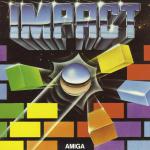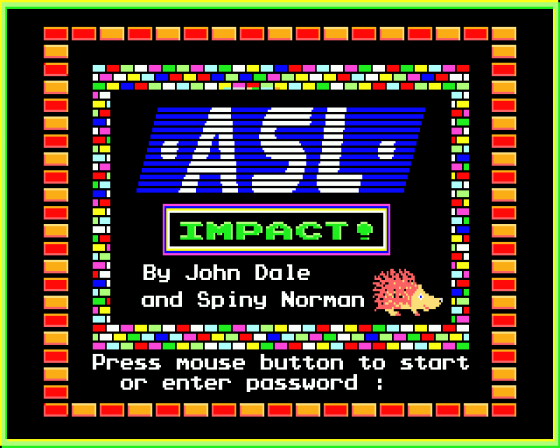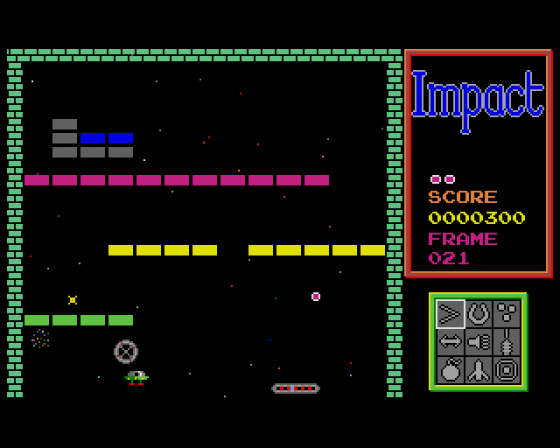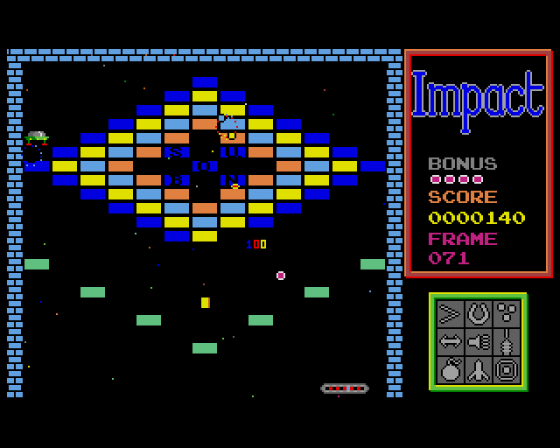
C&VG
 1st October 1987
1st October 1987
Categories: Review: Software
Publisher: Audiogenic
Machine: Amiga 500
Published in Computer & Video Games #72
Impact
If you thought you'd seen the last of the Breakout clones, think again because Audiogenic have come up with a little gem called Impact, available for both ST and the Amiga. Both versions are identical.
Although on the face of it, Impact looks close enough to Arkanoid to make Audiogenic's lawyers tremble at the knees, in fact there are a number of fundamental differences between the two. Indeed, many people may and up buying them both.
The three main features which set Impact apart from all other similar products are the digitised sound effects, the icon/weapon system, and the screen editor.
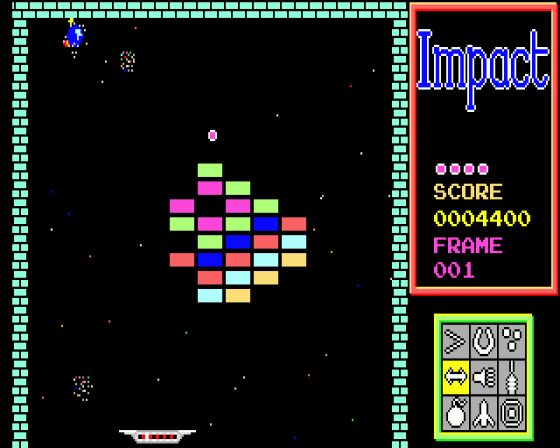
Along with ST Gauntlet, ST Impact must boast the most impressive sound effects yet to grace the Atari 16-bit range. Every fanfare and effect has been sampled to give the game an atmosphere far superior to that possible using the ST's own humble sound capabilities.
Each time the ball hits your bat or one of the brick wall sides, a musical note, or randomly chosen pitch, is played. Close your eyes and you could be forgiven for believing you were listening to someone improvising a tune on a xylophone.
As with certain other games of the same ilk, various sundry items soon start floating towards your bat during play.

These objects range from black holes to Invader-style spaceships, and have the annoying habit of deflecting the ball at all sorts of embarrasing angles.
What makes this feature tolerable, however, is the fantastic sampled explosion that bursts out of the monitor whenever one is destroyed.
Equally impressive is the fanfare that greets you at the start of every game, and the sound effects that accompany warping to the next level and the "game over" message. When you lose a life, the program emits a sound not unlike the mating call of a sperm whale - but played backwards!

Bat and ball movement is smooth and the bricks disintegrate, pixel by pixel, when destroyed.
As with similar games, many bricks must be hit two or more times before they bit the dust. Some deflect back your laser - a particularly nasty way to go! - and some are plain indestructible.
In addition to these, some screens also contain five bricks, each with one of the letters of the word BONUS. Destroy these in order and an extra life is awarded.

All the action takes place against a scrolling starfield, making the ball much easier to follow than in Arkanoid, although this also means the screens lack the 3D feel achieved in the latter using the shadows cast by both bricks and ball onto various textured backgrounds.
Further sound effects can be heard when either bat or ball is given extra powers or weapons.
There are nine different powers you can use, each costing between one and nine bonus capsules. These capsules can be caught as they drop down the screen when certain bricks are hit and destroyed.
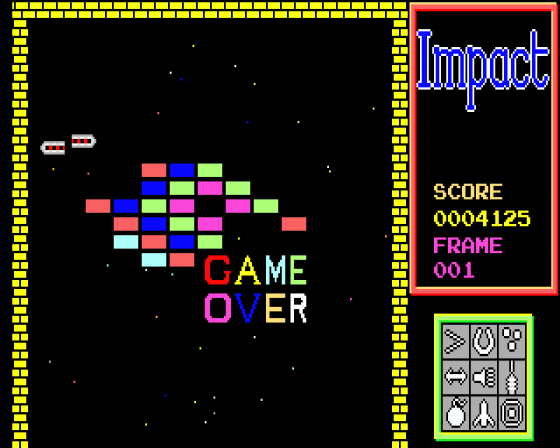
The nine powers are shown in a 3 x 3 matrix of icons, situated beside the play area. These are arranged in order of cost (in bonus capsules) from top left to bottom right.
The flexibility of the weapon/icon system introduces an element of strategy to Impact, not present in other breakout clones. Being able to choose what icons, or combination of icons, to activate, sets the game above the rest. And as if that wasn't enough of a reason to buy it, there's the small matter of eighty different screens.
Mercifully programmer John Dale has implemented a password system allowing instant access to high levels.

So, after you've completed level ten, the program gives you a password which can be entered at the start of subsequent games allowing you to skip the first nine levels. A new password is given every ten screens.
But, after all this, Impact still has one final goody at the bottom of the sack - the screen editor. Although there are 80 pre-defined levels, screens S1-128 have been left blank for the user to create his or her own walls of any shape, size or colour. These can then be saved off, and accessed and played immediately by entering the correct password.
Combine the editor feature with the incredible sound effects and the icon weapon system, stir in liberal portions of playability and addictiveness and Audiogenic have a sure fire ST and Amiga winner on their hands.
Other Reviews Of Impact For The Amiga 500
Impact (Audiogenic)
A review by Christina Erskine (Commodore User)
Scores
Atari ST Version| Graphics | 80% |
| Sound | 99% |
| Value For Money | 99% |
| Playability | 99% |
| Overall | 95% |
Scores
Amiga 500 Version| Graphics | 80% |
| Sound | 99% |
| Value For Money | 99% |
| Playability | 99% |
| Overall | 95% |

